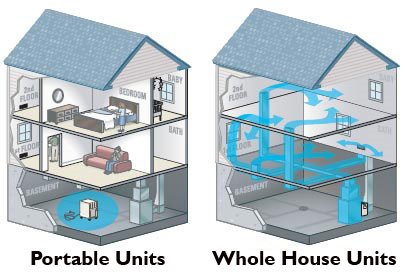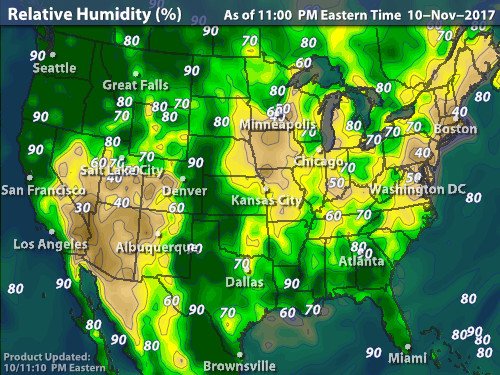
Perhaps you should ask yourself these couple of questions first: Do you have mildew? Perhaps your basement and/or rooms are starting to grow mold? If you’re seeing these signs in multiple places, then the best way to fix that problem is to invest in a whole house dehumidifier.There are a lot of dehumidifiers that works well with small rooms, but how do you find a good one that’s perfect for the entire house? This article will help explain how a whole house dehumidifier works and how its different than any other ones.
Finding a dehumidifier for the entire house can be daunting, especially since this will most likely be more of a permanent machine that you’ll be using for a long time.
We know that looking for a dehumidifier alone can be stressful, especially since there are a lot of different brands with very similar features. However, some can work more efficiently and save you a lot of money in the long run.
How does a dehumidifier for the entire house work?
There are two different types of dehumidifiers, one that is a stand alone unit that can be strong enough to dehumidify a large enough room. Another way is to install it directly to your HVAC system and it dehumidifies the air as it flows back and forth through your air ducts.
In a whole house dehumidifier system, the warm, moist air is pulled into the unit and then cooled. This causes the moisture in air to condense into water droplets.
The droplets can be either drained, collected, or pumped out of the system. The result is dry air, and is then passed into the desired rooms.
Best dehumidifier for whole house in 2019
Aprilaire 1830 70-Pint Whole House Dehumidifier
If you have a problem with mold around the home, then this is one of the top dehumidifiers on the market to fight uncontrollable mold and humidity throughout the home. The 1830 has been rated to remove 70 pints of moisture per day, and can cover homes from 1,400 to 3,800 square feet.
The Aprilaire allows you to “set it and forget it” fashion. You’ll be able to set your humidity levels and let it automatically run to your desire.
The dehumidifier will measure your humidity levels and then it’ll adjust to your needs, allowing it to be hassle free.
Whole House Dehumidifiers vs. Portable Dehumidifiers
First thing is to decide whether you even need a permanent whole house dehumidifier or a portable dehumidifier for large bedrooms. To help illustrate things a little better:

The illustration shows a portable unit vs a whole house system. The portable unit will only dehumidify the room where the unit is located, while the whole house system can dehumidify the entire home.
If you’re seeing problems in more than one area of the house, then it is better off getting a system for the entire house. There is an option of buying multiple portable dehumidifiers, but that just takes up more space, maintenance, and can rack up your expenses pretty easily.
The image below shows the relative humidity (RH) levels of the United States:
![]()

Note that this is a snapshot from intellicast.com taken at 11 PM Eastern Time, on Nov. 10, 2017. If you want to see the levels at various times throughout the day, check out their HUMIDITYcast. You can also see where the most humid cities in the United States are.
With the map shown, you’ll be able to see what levels are the highest (and which is the lowest where you’ll probably need to invest in a good humidity system – opposite of what we’re discussing), which may require a good dehumidifier for your home. The darker green areas show the highest humidity, which has a higher chance of producing mold and mildew in unwanted areas throughout your house.
If you live in these areas, then you’ll be better off installing a dehumidifier system for the entire home because your entire house is going to be affected by the RH in that area, not just one area of your home.
Levels in excess of 70% can lead to major issues such as dust mite, corrosion, insect infestation, termites, and other related deterioration when there’s constant moisture. This is a huge concern amongst allergy and asthma sufferers and can lead to potential dangers.
When you’ve finally decided to invest in a system that can really benefit your health and your home, take these following facts into consideration:
Advantages and Disadvantages of Dehumidifiers for Homes
Here are some of the advantages and disadvantages of getting a whole house system and a portable room dehumidifier. We’ll start with whole house:
Advantages of Whole House Dehumidifiers:
- Control the humidity levels throughout your home.
- Less maintenance.
- Saves room, and is located out of sight.
- Typically lower sound levels.
- Usually more energy efficient.
Disadvantages of Whole House Dehumidifiers:
- The upfront cost can be more expensive.
- More complex to set up, may require professional help.
- May need to change filters out every couple of months or so.
Advantages of Portable Dehumidifiers:
- Lower upfront cost.
- Mobility/portability, most units have casters.
- Easier to install and can be used right away without professional installation.
- Has a good amount of digital controls.
Disadvantages of Portable Dehumidifiers:
- Takes up more space in a room.
- Can be louder when its in operation.
- Only effective in one room, instead of multiple rooms.
- Even with most units having Energy Star certified, its still less energy efficient.
- More maintenance.
Hopefully these advantages and disadvantages can help you determine whether you’ll need a portable unit, or in fact an entire house system.
If you have a home with multiple rooms and walls, then a whole house system would be better.
If you live in a condo or a studio with minimal walls between your rooms, then a portable dehumidifier would suffice.
If you’re more of a visual kind of person, here’s a great explanation of how the stand-alone dehumidifier works:
How To Install a Dehumidifier for Entire House
The video above gives a good explanation of installing your whole house dehumidifier. If you haven’t got the chance, take a moment to watch the short clip.
Here are the steps listed:
- In the attic, attach four steel hanging bars and the metal pan from the collar ties. Position the pan very close to the air-conditioning unit.
- Set the whole-house dehumidifier in the metal pan.
- Cut a square hole in the hallway ceiling and install a new return-air grille.
- Attach a flexible return-air duct to the port on the end of the dehumidifier.
- Secure the duct to the roof framing with plastic straps.
- Cut the duct to length, then attach it to the return-air grille installed in Step 3.
- Cut a new supply-air duct fitting into the air-conditioning unit.
- Connect a flexible supply-air duct to the fitting. Attach the opposite end of the duct to the existing air-conditioning duct system.
- Run a new PVC condensate line from the dehumidifier to the outdoors.
- Install the dehumidifier’s filter; be sure to replace the filter every two to three months.
- Mount a humidistat to the wall beside the existing thermostat.
- Start by setting the humidistat for 35 percent humidity, then adjust as necessary.
Now, of course, these steps may not work for everyone, but at least it’ll give you an idea of what needs to go into installing a whole house dehumidifier.
If you’re still having trouble with installing a dehumidifier on your own, then we suggest you call your local HVAC professional. It’s better to spend the extra money on installing your dehumidifier properly, especially since this is your health you’re dealing with.
Whole House Dehumidifier Features To Look For
You’re going to encounter a lot of different types of dehumidifiers, some may falsely advertise for a whole house system, but is only for basement or crawl space, so it can be important to be familiar to the common features (but not always needed) to look out for.
-
Ducting and Duct Collars
Because of the way whole house dehumidifiers work, the units should have duct collars so you can create a ducting system throughout the house to pull in the moisture throughout the home.
-
Humidistat
You’ll want to be able to control your unit at your convenience. If you encounter a dehumidifier that doesn’t have the capabilities of being controlled by a humidistat, then chances are that they’re not built for the entire home.
-
Condensate Pump
This is usually bought as an addition to the unit, which can help alleviate any maintenance headaches. The pump helps the unit drain the caught droplets and pumped out to a drain. You may not need this, and gravity could get the job done.
-
Low-Temperature Operation
If you live in an area where the ambient temperature is low, then you should check to see if your unit can handle lower temperatures. Higher temperatures are easier to extract the moisture from the air, while its harder for lower temperatures. This will make it more difficult for the dehumidifier to operate.
-
Filtration
These dehumidifiers have filters on the intake that can help clean the air. There are some that are washable or some that needs to be replaced every so often. Make sure that your filter is clog free or it can be difficult for the unit to suck in the air.
Final thoughts about purchasing a dehumidifier for your entire home
We suggest you go with a whole house dehumidifier if you have humidity levels above 70% or in any of the states listed here. If you’re not living in an area where humidity isn’t too high or consistent throughout the day, then a portable dehumidifier would suffice, but it can always vary depending on the living situation.
We hope that you’ve found this article helpful in deciding which direction you should be going to help fight off moisture problems.







